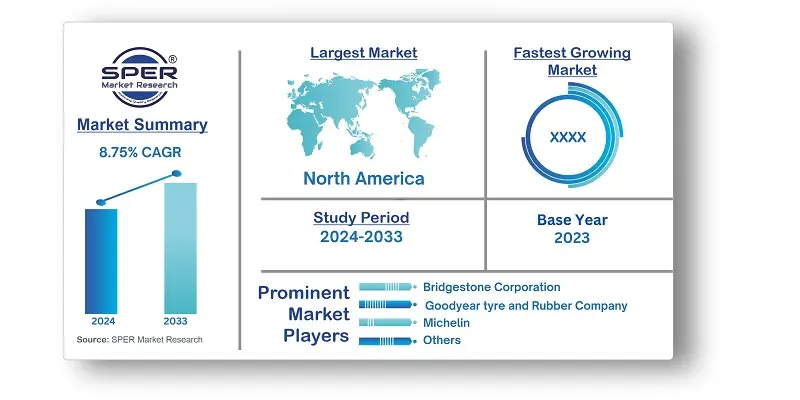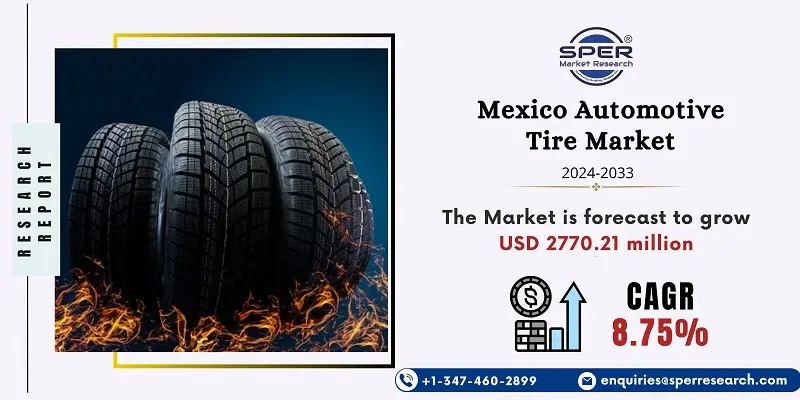
Mexico Automotive Tire Market Growth, Size, Trends, Share, Demand, Revenue and Future Outlook
Mexico Automotive Tire Market Size– By Vehicle Type, By Demand Type, By Price Category, By Tire Type, By Sales Channel- Regional Outlook, Competitive Strategies and Segment Forecast to 2033
| Published: Sep-2024 | Report ID: AMIN24211 | Pages: 1 - 109 | Formats*: |
| Category : Automotive & Transportation | |||
- In 2024, Yokohama Tire Corporation announced that, with the YRC board's consent, it would construct a new consumer and light vehicle tire plant at Saltillo, Coahuila, Mexico's Alianza Industrial Park.
- In 2024: ZC Rubber announced the planned construction of a 60,000 square foot production facility in Saltillo, Mexico.
- The international tyre company Pirelli announced in September 2021 that a USD 36 million investment had been approved to increase the plant's yearly manufacturing capacity to 7.2 million tires in Silao, Mexico.


| Report Metric | Details |
| Market size available for years | 2020-2033 |
| Base year considered | 2023 |
| Forecast period | 2024-2033 |
| Segments covered | By Vehicle Type, By Demand Type, By Price Category, By Tire Type, By Sales Channel |
| Regions covered | North, South, East, West, Central |
| Companies Covered | Bridgestone Corporation, Goodyear tyre and Rubber Company, Michelin, Continental Ag, Hankook Tire and Technology, Yokohama Rubber Co. Ltd, Cooper Tire Rubber Company, Pirelli Tyre S.p.A, Sumitomo Rubber Industries, Toyo tyre Corporation, Maxxis International. |
- Automobile Manufacturers (OEMs)
- Tire Retailers and Distributors
- Independent Repair Shops and Service Centers
- Fleet Operators and Logistics Companies
- Commercial Vehicle Operators (Trucks, Buses, etc.)
- End-Consumers (Vehicle Owners)
- Automotive Dealerships
- Government and Municipal Fleets
- Tire Resellers and Wholesalers
- Rental Car Companies
| By Vehicle Type: | |
| By Demand Type: | |
| By Price Category: | |
| By Tire Type: | |
| By Sales Channel: |
- Mexico Automotive Tire Market Size (FY’2024-FY’2033)
- Overview of Mexico Automotive Tire Market
- Segmentation of Mexico Automotive Tire Market By Vehicle Type (Passenger Car, Light Commercial Vehicle, Medium and Heavy Commercial Vehicle, Two-Wheeler, Three-Wheeler, Off the Road)
- Segmentation of Mexico Automotive Tire Market By Demand Type (OEMs, Replacement)
- Segmentation of Mexico Automotive Tire Market By Price Category (Budget, Economy, Premium)
- Segmentation of Mexico Automotive Tire Market By Tire Type (Radial, Bias)
- Segmentation of Mexico Automotive Tire Market By Sales Channel (Direct Sales, Multi Brand Stores, Exclusive Outlets, Online)
- Statistical Snap of Mexico Automotive Tire Market
- Expansion Analysis of Mexico Automotive Tire Market
- Problems and Obstacles in Mexico Automotive Tire Market
- Competitive Landscape in the Mexico Automotive Tire Market
- Impact of COVID-19 and Demonetization on Mexico Automotive Tire Market
- Details on Current Investment in Mexico Automotive Tire Market
- Competitive Analysis of Mexico Automotive Tire Market
- Prominent Players in the Mexico Automotive Tire Market
- SWOT Analysis of Mexico Automotive Tire Market
- Mexico Automotive Tire Market Future Outlook and Projections (FY’2024-FY’2033)
- Recommendations from Analyst
1.1. Scope of the report1.2. Market segment analysis
2.1. Research data source2.1.1. Secondary Data2.1.2. Primary Data2.1.3. SPER’s internal database2.1.4. Premium insight from KOL’s2.2. Market size estimation2.2.1. Top-down and Bottom-up approach2.3. Data triangulation
4.1. Driver, Restraint, Opportunity and Challenges analysis4.1.1. Drivers4.1.2. Restraints4.1.3. Opportunities4.1.4. Challenges4.2. COVID-19 Impacts of the Mexico Automotive Tire Market.
5.1. SWOT Analysis5.1.1. Strengths5.1.2. Weaknesses5.1.3. Opportunities5.1.4. Threats5.2. PESTEL Analysis5.2.1. Political Landscape5.2.2. Economic Landscape5.2.3. Social Landscape5.2.4. Technological Landscape5.2.5. Environmental Landscape5.2.6. Legal Landscape5.3. PORTER’s Five Forces5.3.1. Bargaining power of suppliers5.3.2. Bargaining power of buyers5.3.3. Threat of Substitute5.3.4. Threat of new entrant5.3.5. Competitive rivalry5.4. Heat Map Analysis
6.1. Mexico Automotive Tire Market Manufacturing Base Distribution, Sales Area, Product Type6.2. Mergers & Acquisitions, Partnerships, Product Launch, and Collaboration in Mexico Automotive Tire Market
7.1. Mexico Automotive Tire Market Size, Share and Forecast, By Vehicle Type, 2020-20267.2. Mexico Automotive Tire Market Size, Share and Forecast, By Vehicle Type, 2027-20337.3. Passenger Car7.4. Light Commercial vehicle7.5. Medium & Heavy Commercial Vehicle7.6. Two-Wheeler7.7. Three-Wheeler7.8. Off the Road
8.1. Mexico Automotive Tire Market Size, Share and Forecast, By Demand Type, 2020-20268.2. Mexico Automotive Tire Market Size, Share and Forecast, By Demand Type, 2027-20338.3. OEMs8.4. Replacement
9.1. Mexico Automotive Tire Market Size, Share and Forecast, By Price Category, 2020-20269.2. Mexico Automotive Tire Market Size, Share and Forecast, By Price Category, 2027-20339.3. Budget9.4. Economy9.5. Premium
10.1. Mexico Automotive Tire Market Size, Share and Forecast, By Tire Type, 2020-202610.2. Mexico Automotive Tire Market Size, Share and Forecast, By Tire Type, 2027-203310.3. Radial10.4. Bias
11.1. Mexico Automotive Tire Market Size, Share and Forecast, By Sales Channel, 2020-202611.2. Mexico Automotive Tire Market Size, Share and Forecast, By Sales Channel, 2027-203311.3. Direct Sales11.4. Multi Brand Stores11.5. Exclusive Outlets11.6. Online
12.1. Mexico Automotive Tire Market Size and Market Share
13.1. Mexico Automotive Tire Market Size and Market Share By Region (2020-2026)13.2. Mexico Automotive Tire Market Size and Market Share By Region (2027-2033)13.3. North13.4. South13.5. East13.6. West13.7. Central
14.1. Bridgestone Corporation14.1.1. Company details14.1.2. Financial outlook14.1.3. Product summary14.1.4. Recent developments14.2. Goodyear tyre and Rubber Company14.2.1. Company details14.2.2. Financial outlook14.2.3. Product summary14.2.4. Recent developments14.3. Michelin14.3.1. Company details14.3.2. Financial outlook14.3.3. Product summary14.3.4. Recent developments14.4. Continental Ag14.4.1. Company details14.4.2. Financial outlook14.4.3. Product summary14.4.4. Recent developments14.5. Hankook Tire and Technology14.5.1. Company details14.5.2. Financial outlook14.5.3. Product summary14.5.4. Recent developments14.6. Yokohama Rubber Co. Ltd14.6.1. Company details14.6.2. Financial outlook14.6.3. Product summary14.6.4. Recent developments14.7. Cooper Tire Rubber Company14.7.1. Company details14.7.2. Financial outlook14.7.3. Product summary14.7.4. Recent developments14.8. Pirelli Tyre S.p.A14.8.1. Company details14.8.2. Financial outlook14.8.3. Product summary14.8.4. Recent developments14.9. Sumitomo Rubber Industries14.9.1. Company details14.9.2. Financial outlook14.9.3. Product summary14.9.4. Recent developments14.10. Toyo tyre Corporation14.10.1. Company details14.10.2. Financial outlook14.10.3. Product summary14.10.4. Recent developments14.11. Maxxis International14.11.1. Company details14.11.2. Financial outlook14.11.3. Product summary14.11.4. Recent developments14.12. Others
SPER Market Research’s methodology uses great emphasis on primary research to ensure that the market intelligence insights are up to date, reliable and accurate. Primary interviews are done with players involved in each phase of a supply chain to analyze the market forecasting. The secondary research method is used to help you fully understand how the future markets and the spending patterns look likes.
The report is based on in-depth qualitative and quantitative analysis of the Product Market. The quantitative analysis involves the application of various projection and sampling techniques. The qualitative analysis involves primary interviews, surveys, and vendor briefings. The data gathered as a result of these processes are validated through experts opinion. Our research methodology entails an ideal mixture of primary and secondary initiatives.



Frequently Asked Questions About This Report
PLACE AN ORDER
Year End Discount
Sample Report
Pre-Purchase Inquiry
NEED CUSTOMIZATION?
Request CustomizationCALL OR EMAIL US
100% Secure Payment






Related Reports
Our Global Clients
Our data-driven insights have influenced the strategy of 200+ reputed companies across the globe.






















